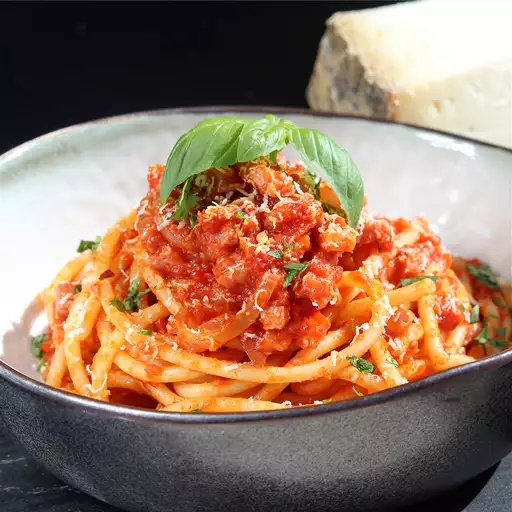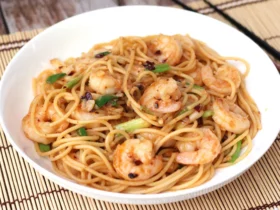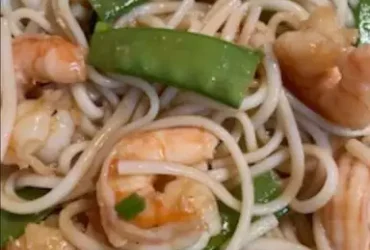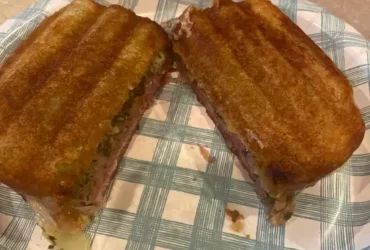Background and History
Bucatini all’Amatriciana is a classic Italian pasta dish hailing from Amatrice, a town in the Lazio region. This dish dates back to the 18th century and is known for its simple yet flavorful combination of guanciale (cured pork cheek), tomatoes, and Pecorino Romano cheese. Traditionally, it’s made with bucatini, a thick spaghetti-like pasta with a hole running through the center. Bucatini all’Amatriciana exemplifies the rustic, hearty cuisine of central Italy.
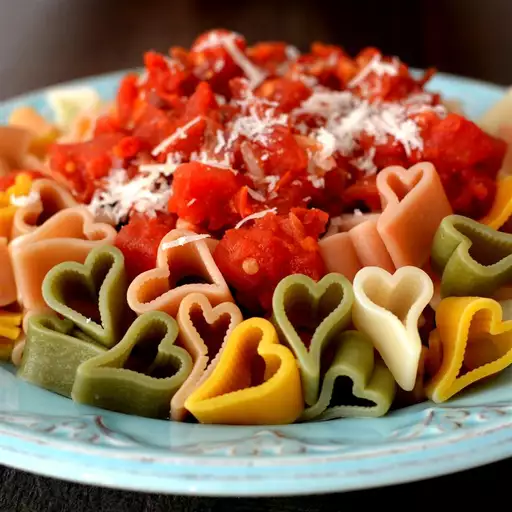
Recipe Guide
Serves
- 4 people
Time
- Total preparation time: 10 minutes
Cooking Time
- Cooking time: 20 minutes
Ingredients
- 400 grams (14 oz) bucatini pasta
- 150 grams (5.3 oz) guanciale (or pancetta) cut into small strips
- 400 grams (14 oz) canned peeled tomatoes
- 1/2 cup grated Pecorino Romano cheese
- 1 small red chili pepper, chopped (optional)
- 2 tablespoons olive oil
- 1/2 cup dry white wine
- Salt to taste
- Freshly ground black pepper to taste
Instructions
Prepare the Ingredients:
Cut the guanciale into small strips.
Crush the canned tomatoes with your hands or a fork.
Cook the Guanciale
- Heat the olive oil in a large skillet over medium heat.
- Add the guanciale and cook until it becomes crispy and golden, about 5-7 minutes.
- If using, add the chopped red chili pepper and cook for another minute.
Add Wine and Tomatoes
- Pour in the white wine and let it simmer until reduced by half, about 2-3 minutes.
- Add the crushed tomatoes to the skillet, stirring to combine.
- Season with salt and black pepper.
- Let the sauce simmer for about 10-15 minutes, until it thickens.
Cook the Pasta
- While the sauce is simmering, bring a large pot of salted water to a boil.
- Add the bucatini and cook according to package instructions, until al dente.
- Reserve 1/2 cup of pasta cooking water, then drain the pasta.
Combine Pasta and Sauce
- Add the cooked bucatini to the skillet with the sauce.
- Toss to combine, adding a bit of the reserved pasta water if needed to loosen the sauce.
Serve
- Divide the pasta among plates.
- Sprinkle generously with grated Pecorino Romano cheese.
- Serve immediately and enjoy!
Nutrition Facts (per serving)
- Calories: 550
- Protein: 20g
- Carbohydrates: 70g
- Fat: 20g
- Saturated Fat: 7g
- Fiber: 4g
- Sugar: 7g
- Sodium: 900mg
Notes
- Guanciale is traditional, but pancetta or even thick-cut bacon can be used as a substitute if necessary.
- For a slightly different flavor, you can add a splash of balsamic vinegar to the sauce.
- The dish pairs well with a light salad and a glass of dry white wine.
Allergy Warning
- Contains gluten (pasta)
- Contains dairy (cheese)
- Contains pork (guanciale)
What is bucatini all’Amatriciana made of?
Bucatini all’Amatriciana is made of bucatini pasta, guanciale (cured pork cheek), tomatoes, Pecorino Romano cheese, olive oil, white wine, and optional red chili pepper for a slight kick.
What does all’Amatriciana mean in Italian?
“All’Amatriciana” means “in the style of Amatrice,” referring to the town of Amatrice in Italy where the dish originated.
What is bucatini made of?
Bucatini is a type of pasta made from durum wheat flour and water. It is similar to spaghetti but thicker and has a hole running through the center.
What is the difference between arrabbiata and amatriciana?
Arrabbiata sauce is made with tomatoes, garlic, and red chili peppers, making it spicy. Amatriciana sauce includes guanciale and Pecorino Romano cheese, adding a rich, savory flavor.
What is the difference between carbonara and amatriciana?
Carbonara is made with eggs, Pecorino Romano cheese, guanciale, and black pepper, creating a creamy sauce without tomatoes. Amatriciana includes tomatoes and lacks eggs, giving it a tomato-based sauce.
Why does arrabbiata mean angry?
“Arrabbiata” means “angry” in Italian, referring to the spiciness of the sauce from the red chili peppers, which can make the dish fiery.
What can I substitute for amatriciana?
If you can’t find guanciale, you can substitute pancetta or thick-cut bacon. For a vegetarian version, use smoked tofu or mushrooms for a similar smoky flavor.
Why is it called arrabbiata?
It is called “arrabbiata” because of the spicy heat from the red chili peppers, which can make one feel “angry” or fiery due to the intense spiciness.
Why is it called Ragu?
“Ragu” comes from the French word “ragout,” which means a slow-cooked stew. In Italian cuisine, it refers to a meat-based sauce simmered for a long time.
Why is it called marinara?
“Marinara” means “sailor-style” in Italian. The sauce was originally made by sailors using simple ingredients like tomatoes, garlic, and herbs, which were easy to preserve on long voyages.
- Best Lusha Alternatives for 2025 - April 22, 2025
- Best Overloop Alternatives for 2025 - April 22, 2025
- Best 6sense Alternatives for 2025 - April 22, 2025

